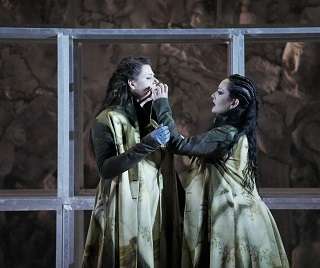|
Back
A Stylized Love Affair Pesaro
Vitrifrigo Arena
08/11/2023 - & August 14, 17, 20*, 2023
Gioachino Rossini: Eduardo e Cristina
Enea Scala (Carlo), Anastasia Bartoli (Cristina), Daniela Barcellona (Eduardo), Grigory Shkarupa (Giacomo), Matteo Roma (Altei)
Coro del Teatro Ventidio Basso, Giovanni Farina (chorus master), Orchestra Sinfonica Nazionale della RAI, Jader Bignamini (conductor)
Stefano Poda (stage director, sets, costumes, lighting, choreography)

D. Barcellona, A. Bartoli (© Amati Bacciardi Studio)
Long considered a pastiche using music from other operas, Pesaro’s Rossini Opera Festival didn’t consider Eduardo e Cristina to be a valid work until recently. However, upon closer inspection, it is shown to be an authentic work despite considerable recycled passages. Indeed, the best moments of this 1819 opera are similar to those of Rossini’s best opera seria, Ermione (1819). Other moments are from Adelaide di Borgogna (1817) and Ricciardo e Zoraide (1818). This is the opera’s first appearance at the festival.
In the early 19th century, the likelihood of an opera performed in Naples (Ermione, Ricciardo e Zoraide) being heard by the public in Venice (Eduardo e Cristina) was slim, as travel was not as easy or affordable as it is today. Naples was the capital of the Kingdom of Two Sicilies and Venice was a city in the Austro-Hungarian Empire. This was further augmented by Naples having exclusive performance rights of the operas it commissioned. Therefore, Rossini’s liberties in borrowing his own music for works seen by different publics was in this context completely understandable.
The opera takes place in the 17th century, when Sweden was a major European power ruling most of Scandinavia, the Baltic, Pomerania and smaller enclaves of Northern Germany. Sweden’s main rival was a rising Russia which eventually defeated it in the Battle of Poltava (1709) and rendered it a minor power.
Eduardo e Cristina opens with the Swedes celebrating their victory over the Russians. Their victorious commander, Eduardo, is secretly married to the king’s daughter Cristina and they have a child, Gustavo. With his victory, Eduardo hopes to be allowed to ask for Cristina’s hand and finally legitimize their secret affair. However, King Carlo announces his daughter’s upcoming marriage to the Scottish prince and ally, Giacomo (James). Cristina shows her disinterest, despite her father’s insistence. At the end of the first act, little Gustavo is discovered in his mother’s quarters and Cristina confesses that he is her child. She, her child and the yet unknown father are condemned to death. In the second act, Eduardo comes forward and announces he’s the father and begs for his wife and child’s life, but he too is to die. Luckily for the doomed couple, the Russians attack again. All seems lost until Eduardo is freed in order to lead the Swedish forces. Thanks to a second victory, he’s pardoned and allowed to live happily with his wife Cristina and their child.
The plot is not too weak for an early nineteenth century opera, but the libretto is, as it doesn’t allow for the development of its characters. Dramatically, the most successfully written role is that of King Carlo, masterfully interpreted by tenor Enea Scala, who easily fulfills the demands of the role. Scala’s voice has matured over time, evolving into a much larger instrument. He’s still comfortable in the role’s high tessiture, and his technique is admirable. However, his voice’s colour is less appealing than it once was.
In most operas, tenor and soprano are typically the romantic leads, but Rossini had opted for the tenor as the father in other operas such as Maometto II (1820) and Tancredi (1813), giving a contralto or a mezzo the male lover’s part. A veteran of this festival, Daniela Barcellona is no stranger to Rossini’s trouser roles, having sung on the world’s major stages Tancredi, Calbo (Maometto II), Arsace (Semiramide) and Malcolm (La donna del lago). Here, she portrayed a valiant and moving Eduardo. As with Enea Scala, she is still impressive but her voice has lost its once formidable power.
Making her Pesaro debut, soprano Anastasia Bartoli dazzled with a larger than life stage presence and a heftier voice than one is used to in the bel canto repertoire. Daughter of Cecilia Gasdìa, a prominent Rossini soprano in the 80s and 90s, Bartoli has thus far sung mostly Verdi and Puccini. Nonetheless, her excellent technique, warm timbre and well‑supported high notes are a winning combination. As the role is not well‑developed dramatically, only a soprano with immense charisma and vocal prowess can animate Cristina, and this she did.
Russian bass Grigory Shkarupa was a sympathetic Giacomo. One would have hoped this role was bigger, as Shkarupa shows promise. Also, it would have made for more dramatic balance.
In addition to the great singing in this opera, the stage direction was a triumph. The talented stage director Stefano Poda, who is also the set and costume designer and the choreographer, opted for a stylized interpretation, a wise choice given the weak development of the two leading characters. The opera opened to a white mural of striking faces center stage, and on both sides was a gallery of what looked like suspended white corpses draped in white. This may have been Poda’s way to emphasize the devastation of war. Members of the choir were dressed in dignified white robes and the corps de ballet were almost naked, and painted the same white. The dancers were present on stage throughout the opera. To some, this was a major distraction. I found it appropriate despite its abstract nature. The dancers expressed the inner feelings of Eduardo and Cristina, joy after victory in battle; joy in reuniting; anguish at being found out, and the pain of separation. The choreography was at once elegant and expressive.
Jader Bignamini led an initially tentative Orchestra Sinfonica Nazionale della RAI, but soon all was under control. Thanks to both the inventive staging and choreography as well as superlative voices, this was a memorable introduction to an opera heretofore unknown.
Ossama el Naggar
|